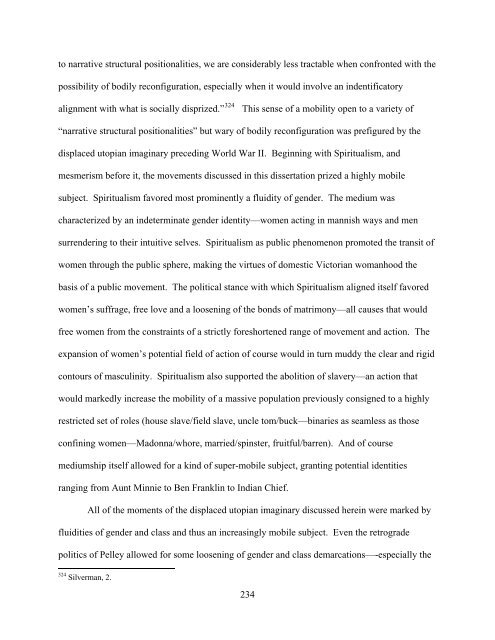A Genealogy of the Extraterrestrial in American Culture
A Genealogy of the Extraterrestrial in American Culture
A Genealogy of the Extraterrestrial in American Culture
Create successful ePaper yourself
Turn your PDF publications into a flip-book with our unique Google optimized e-Paper software.
to narrative structural positionalities, we are considerably less tractable when confronted with <strong>the</strong><br />
possibility <strong>of</strong> bodily reconfiguration, especially when it would <strong>in</strong>volve an <strong>in</strong>dentificatory<br />
alignment with what is socially disprized.” 324<br />
This sense <strong>of</strong> a mobility open to a variety <strong>of</strong><br />
“narrative structural positionalities” but wary <strong>of</strong> bodily reconfiguration was prefigured by <strong>the</strong><br />
displaced utopian imag<strong>in</strong>ary preced<strong>in</strong>g World War II. Beg<strong>in</strong>n<strong>in</strong>g with Spiritualism, and<br />
mesmerism before it, <strong>the</strong> movements discussed <strong>in</strong> this dissertation prized a highly mobile<br />
subject. Spiritualism favored most prom<strong>in</strong>ently a fluidity <strong>of</strong> gender. The medium was<br />
characterized by an <strong>in</strong>determ<strong>in</strong>ate gender identity—women act<strong>in</strong>g <strong>in</strong> mannish ways and men<br />
surrender<strong>in</strong>g to <strong>the</strong>ir <strong>in</strong>tuitive selves. Spiritualism as public phenomenon promoted <strong>the</strong> transit <strong>of</strong><br />
women through <strong>the</strong> public sphere, mak<strong>in</strong>g <strong>the</strong> virtues <strong>of</strong> domestic Victorian womanhood <strong>the</strong><br />
basis <strong>of</strong> a public movement. The political stance with which Spiritualism aligned itself favored<br />
women’s suffrage, free love and a loosen<strong>in</strong>g <strong>of</strong> <strong>the</strong> bonds <strong>of</strong> matrimony—all causes that would<br />
free women from <strong>the</strong> constra<strong>in</strong>ts <strong>of</strong> a strictly foreshortened range <strong>of</strong> movement and action. The<br />
expansion <strong>of</strong> women’s potential field <strong>of</strong> action <strong>of</strong> course would <strong>in</strong> turn muddy <strong>the</strong> clear and rigid<br />
contours <strong>of</strong> mascul<strong>in</strong>ity. Spiritualism also supported <strong>the</strong> abolition <strong>of</strong> slavery—an action that<br />
would markedly <strong>in</strong>crease <strong>the</strong> mobility <strong>of</strong> a massive population previously consigned to a highly<br />
restricted set <strong>of</strong> roles (house slave/field slave, uncle tom/buck—b<strong>in</strong>aries as seamless as those<br />
conf<strong>in</strong><strong>in</strong>g women—Madonna/whore, married/sp<strong>in</strong>ster, fruitful/barren). And <strong>of</strong> course<br />
mediumship itself allowed for a k<strong>in</strong>d <strong>of</strong> super-mobile subject, grant<strong>in</strong>g potential identities<br />
rang<strong>in</strong>g from Aunt M<strong>in</strong>nie to Ben Frankl<strong>in</strong> to Indian Chief.<br />
All <strong>of</strong> <strong>the</strong> moments <strong>of</strong> <strong>the</strong> displaced utopian imag<strong>in</strong>ary discussed here<strong>in</strong> were marked by<br />
fluidities <strong>of</strong> gender and class and thus an <strong>in</strong>creas<strong>in</strong>gly mobile subject. Even <strong>the</strong> retrograde<br />
politics <strong>of</strong> Pelley allowed for some loosen<strong>in</strong>g <strong>of</strong> gender and class demarcations—-especially <strong>the</strong><br />
324 Silverman, 2.<br />
234















